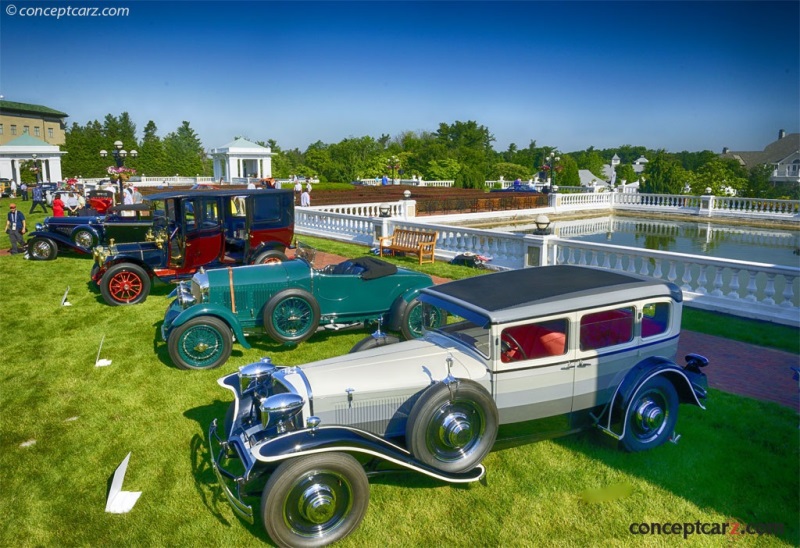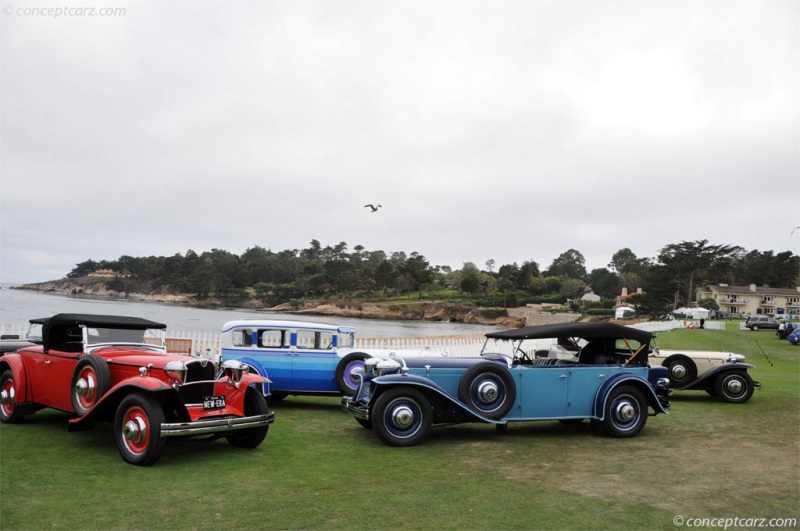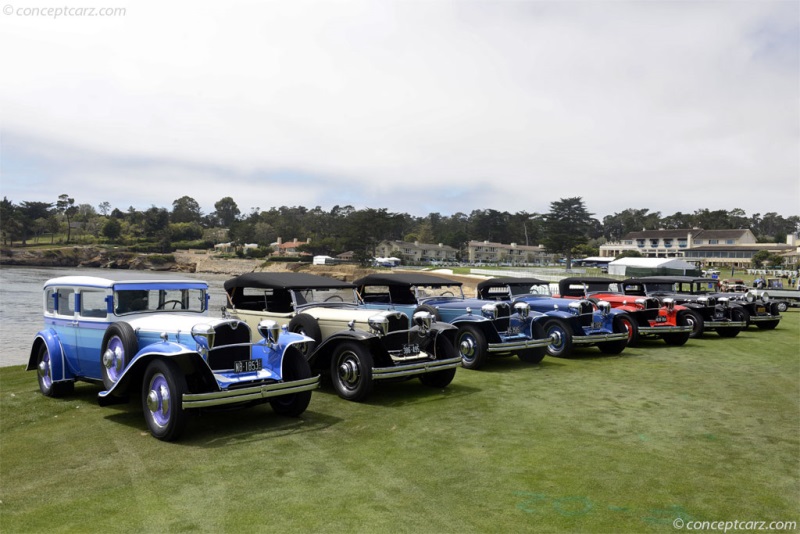History
The Ruxton is a forgotten manufacturer, often overlooked when considering early pioneers in automotive design and mechanics. One of their biggest automotive achievements was the use of front-drive automobiles. In 1966, Oldsmobile introduced the Toronado, a front-wheel-drive vehicle and the only American-built front-drive vehicle since the Cord. When Ruxton introduced their version, it was roughly the same time that Cord introduced theirs however it was Cord that survived longer.
William Muller, an employee of Edward G. Budd Manufacturing Co. of Philadelphia and a racing engineer, was instrumental in the design and development of many of the components on the Ruxton. The body was styled by Budd Manufacturing Co's chief engineer Joseph Ledwinka. The resulting automobile was a large and luxurious automobile with the engine in the front and unconventionally powering the front wheels. Because it was front-drive, the vehicle was able to sit lower than most cars and lowering its center of gravity making it stable at speed.
Archie Andrews, a member of Budd's board of directors and a Wall Street financier was fascinated by the vehicle and immediately acquired the prototype. He approached Hupmobiles with hopes of having them produce it. When negotiations fell through, Andrews decided to produce the vehicle himself. In 1929, he formed the New Era Motors Inc. He hired Muller as vice-president. Muller handled the engineering aspects while Andrews sought financial backing which he found in a New York stockbroker named William Ruxton. Andrews decided to name the automobile after his new found friend, unfortunately, Andrews never received any money from Ruxton.
Andrews approached Gardner Motor Co, located in St. Louis. Just like the incident with Hupmobiles, Gardner Motor Company showed desire but eventually pulled out of the deal. Disappointed, Andrews approached Marmon Motor Car Company located in Indianapolis. One the day the agreement was signed, the stock market crashed and Marmon Motor Car Company declined the agreement. Jordan, Stutz, and Pierce were approached by Andrews but none wanted to build the Ruxton. Finally, a deal was struck with the Moon Motor Car Company and by the middle of 1930, the Ruxton had begun producing.
The facilities, according to Muller, were unsuitable so Andrews approached the Kisser Motor Company concerning the use of their facilities. They agreed and soon the Ruxton was being produced in St. Louis at the Moon facility and in Hartford, Wisconsin at the Kisser Motor Company.
The engine that powered the Ruxton was a Continental 4.4 liter side-valve, straight-eight cylinder engine capable of producing 100 horsepower. The three-speed manual gearbox was of Muller-design and was rather unique. It was split with the second and third gears behind the worm-drive differential and the first and reverse gears in front of it.
A spare tire was mounted on the outside in front of the driver's door. There were no running boards and the fenders were long and slightly sloped. An optional 'Woodlite' headlamp was available.
The Great Depression was a difficult time for many. The ones that were hurt the most were the manufacturers that offered mostly high-priced, luxury automobiles. Since the Depression greatly reduced the amount of spending power of many individuals, they were often the first to go out of business. The Ruxton cost roughly $3,000, a price tag that was out of the reach for most buyers. After about 500 examples were produced, Ruxton closed its doors and ceased production.
By Daniel Vaughan | Apr 2007
William Muller, an employee of Edward G. Budd Manufacturing Co. of Philadelphia and a racing engineer, was instrumental in the design and development of many of the components on the Ruxton. The body was styled by Budd Manufacturing Co's chief engineer Joseph Ledwinka. The resulting automobile was a large and luxurious automobile with the engine in the front and unconventionally powering the front wheels. Because it was front-drive, the vehicle was able to sit lower than most cars and lowering its center of gravity making it stable at speed.
Archie Andrews, a member of Budd's board of directors and a Wall Street financier was fascinated by the vehicle and immediately acquired the prototype. He approached Hupmobiles with hopes of having them produce it. When negotiations fell through, Andrews decided to produce the vehicle himself. In 1929, he formed the New Era Motors Inc. He hired Muller as vice-president. Muller handled the engineering aspects while Andrews sought financial backing which he found in a New York stockbroker named William Ruxton. Andrews decided to name the automobile after his new found friend, unfortunately, Andrews never received any money from Ruxton.
Andrews approached Gardner Motor Co, located in St. Louis. Just like the incident with Hupmobiles, Gardner Motor Company showed desire but eventually pulled out of the deal. Disappointed, Andrews approached Marmon Motor Car Company located in Indianapolis. One the day the agreement was signed, the stock market crashed and Marmon Motor Car Company declined the agreement. Jordan, Stutz, and Pierce were approached by Andrews but none wanted to build the Ruxton. Finally, a deal was struck with the Moon Motor Car Company and by the middle of 1930, the Ruxton had begun producing.
The facilities, according to Muller, were unsuitable so Andrews approached the Kisser Motor Company concerning the use of their facilities. They agreed and soon the Ruxton was being produced in St. Louis at the Moon facility and in Hartford, Wisconsin at the Kisser Motor Company.
The engine that powered the Ruxton was a Continental 4.4 liter side-valve, straight-eight cylinder engine capable of producing 100 horsepower. The three-speed manual gearbox was of Muller-design and was rather unique. It was split with the second and third gears behind the worm-drive differential and the first and reverse gears in front of it.
A spare tire was mounted on the outside in front of the driver's door. There were no running boards and the fenders were long and slightly sloped. An optional 'Woodlite' headlamp was available.
The Great Depression was a difficult time for many. The ones that were hurt the most were the manufacturers that offered mostly high-priced, luxury automobiles. Since the Depression greatly reduced the amount of spending power of many individuals, they were often the first to go out of business. The Ruxton cost roughly $3,000, a price tag that was out of the reach for most buyers. After about 500 examples were produced, Ruxton closed its doors and ceased production.
By Daniel Vaughan | Apr 2007
William J. Muller was a development engineer at Budd and Briggs, an automotive body building contractor, and a proponent of the front wheel drive system. It was common practice for coachbuilding companies such as Budd and Briggs to demonstrate new ideas and capabilities to major manufacturers to stimulate business.
The Ruxton was conceived by Muller with designs created in 1926 and a prototype version completed two years later. It had a proprietary chassis with a Studebaker six-cylinder engine and Warner gearbox. The prototype was brought to New York in 1929 where it generated much interest and curiosity. The front-drive system allowed the car to sit very low, around 10-inches lower than most of its competitors. In the front center of the vehicle was the emblem created by Budd. It was an oval with a '?' in its center.
The front-drive prototype interested Archie M. Andrews who quickly formed New Era Motors, Inc., with the intent to build it with assistance from Muller. The car was named the Ruxton, in hopes of landing financial backing from William V.C. Ruxton, an influential businessman living in New York. Unfortunately, the businessman was not interested.
A few short months after the formation of the New Era Motors, the production version was complete. The drive-train was completely different, now being powered by a Continental 18S eight-cylinder unit. The engine was mounted further forward in the engine bay which aided in weight distribution. The move forward was made possible by splitting the transmission with the low and reverse in front of the differential. Second and third was placed behind it. Also, the crown and pinion gearing was replaced by worm drive.
The Ruxton had only one other front-wheel drive competitor at the time: the Cord L-29 which had been introduced in late 1929. In comparison, the Ruxton was lower, had better balance, lighter, had better unsprung weight, and had better ride and handling. Cord, on the other hand, had its own manufacturing plant and an established dealer network. Muller and Andrews were still searching for interested personnel to produce their vehicle. Many established manufacturers were approached but most declined. The list included Gardner in St. Lous, Hupp Manufacturing, and Indianapolis-based Marmon.
The car was eventually produced by Moon while manufacture of the transaxles and several complete cars were subcontracted to Wisconsin-based Kissel Company.
The Ruxton's were doomed from the start; the demise of the economy due to the Great Depression plus the lack of an established dealer-network meant only a handful would ever be created. It is unknown exactly how many examples were created, though it is believed that around 500 were created. Other estimates put that number much lower, at around 100. In modern times, fewer than ten are known to exist.
By Daniel Vaughan | Sep 2008
The Ruxton was conceived by Muller with designs created in 1926 and a prototype version completed two years later. It had a proprietary chassis with a Studebaker six-cylinder engine and Warner gearbox. The prototype was brought to New York in 1929 where it generated much interest and curiosity. The front-drive system allowed the car to sit very low, around 10-inches lower than most of its competitors. In the front center of the vehicle was the emblem created by Budd. It was an oval with a '?' in its center.
The front-drive prototype interested Archie M. Andrews who quickly formed New Era Motors, Inc., with the intent to build it with assistance from Muller. The car was named the Ruxton, in hopes of landing financial backing from William V.C. Ruxton, an influential businessman living in New York. Unfortunately, the businessman was not interested.
A few short months after the formation of the New Era Motors, the production version was complete. The drive-train was completely different, now being powered by a Continental 18S eight-cylinder unit. The engine was mounted further forward in the engine bay which aided in weight distribution. The move forward was made possible by splitting the transmission with the low and reverse in front of the differential. Second and third was placed behind it. Also, the crown and pinion gearing was replaced by worm drive.
The Ruxton had only one other front-wheel drive competitor at the time: the Cord L-29 which had been introduced in late 1929. In comparison, the Ruxton was lower, had better balance, lighter, had better unsprung weight, and had better ride and handling. Cord, on the other hand, had its own manufacturing plant and an established dealer network. Muller and Andrews were still searching for interested personnel to produce their vehicle. Many established manufacturers were approached but most declined. The list included Gardner in St. Lous, Hupp Manufacturing, and Indianapolis-based Marmon.
The car was eventually produced by Moon while manufacture of the transaxles and several complete cars were subcontracted to Wisconsin-based Kissel Company.
The Ruxton's were doomed from the start; the demise of the economy due to the Great Depression plus the lack of an established dealer-network meant only a handful would ever be created. It is unknown exactly how many examples were created, though it is believed that around 500 were created. Other estimates put that number much lower, at around 100. In modern times, fewer than ten are known to exist.
By Daniel Vaughan | Sep 2008
Ruxton
Similarly Priced Vehicles
- Cadillac Series 355-A Eight ($2,700-$3,800)
- Pierce-Arrow Model 43 ($2,700-$3,700)
Average Auction Sale: $331,833
1931 Ruxton Model C Vehicle Profiles
Recent Vehicle Additions
Performance and Specification Comparison
Price Comparison
Model C Specification Comparison by Year
Year
Production
Wheelbase
Engine
Prices
Related Automotive News

The all-new Škoda Superb: More space, more comfort, more efficiency and more safety
Refined flagship ICE model distinguished new look, more advanced aerodynamicsMore space and comfort roomier, clean interior design featuring sustainable materials, intuitive...

Make Lancia Great Again: London Concours Reveals Lancia Legends Display
The London Concours has announced its Lancia Legends display – a celebration of cars from the golden era of Lancia
Line-up includes icons like Henri Toivonens Lancia 037 Rally Evo 2, a one-of-59 B24 Spider and the ultimate Flaminia a Super Sport...

RM Auctions to Present The Merrick Auto Museum Collection at 13th Annual Hershey Sale
OVER 100 BRASS ERA CARS AND SELECTION OF MEMORABILIA OFFERED ENTIRELY WITHOUT RESERVE
RM Auctions set to offer the Merrick Auto Museum Collection at Hershey auction, 10-11 October in Pennsylvania
Offered entirely without reserve, the multi...

The Champion in Touring Car Racing : The BMW M3
In August 1985, a rumour surfaced in motor magazine Auto-Deutschland which emanated from a new sports car. An A Group Car from BMW that was a thoroughbred racing car according to the rules but was also to be produced in a version licensed to drive on...

Auctions America By RM's 2012 Auburn Spring Auction
Variety is the buzzword for this years Auctions America by RM June 1-3 Auburn Spring auction, which will offer a huge range of collector vehicles and an enormous private collection of automotive memorabilia. More than 600 American muscle cars, Classics,...






































